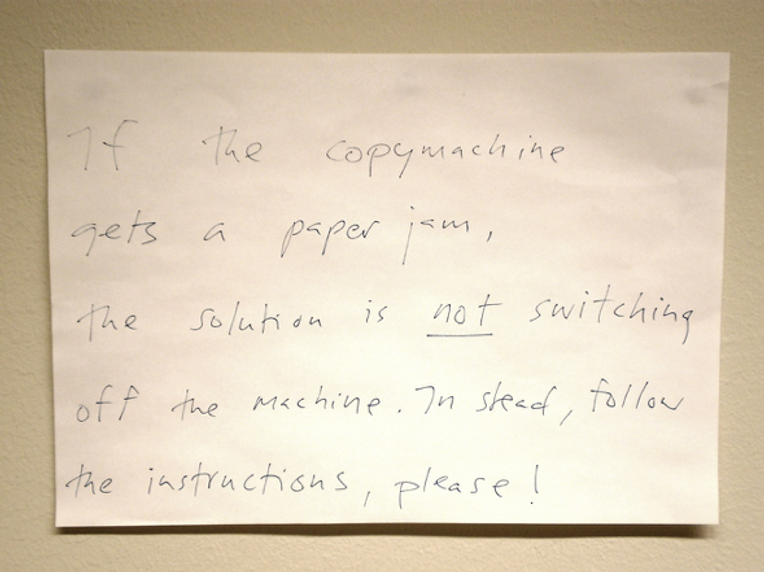Interface
From the Series: Keywords for Ethnography and Design
From the Series: Keywords for Ethnography and Design

Interface is a term widely used both in common everyday talk, which inevitably reflects the role of technology in our lives, as well as in such disciplines computer science, industrial design and usability. Human–machine interface would be a more exact term, denoting that part of a device that has been designed in order to provide the human user with some means for control over the device’s behavior. Thinking that devices have their own behavior presumes that their internal states and structures are not fully visible or transparent to user, but are instead to some extent mapped onto certain surface structures. These can be either physical objects such as LEDs and buttons and switches, or elements of software, visualized in graphic user interface or in some other form made perceivable to users. Users can interpret these as representations of internal states and also as controls for operating the device. For anthropology, there are several topics that appear of interest with relation to interface. Humans employ technology as extension of their bodies and minds, and not only bodies and minds are culturally shaped, but their extensions and the ways in which humans interact with these extensions, too. Interface is about control and communication.

This image could be a piece of contemporary art, but it is not, though it illustrates the potentialities of ethnography as input to art projects. The photograph was taken in 2014 in a huge residential facility for persons with intellectual disabilities in Russia. Happily, I was not alone in the elevator when I saw this for the first time, otherwise I would have been in trouble and wouldn’t have been able to find my way. Local users, and not only the personnel of the institution but also those inmates who are allowed to leave their own department, have in their heads all the knowledge required for the use of the elevator. Actually, this vernacular design with handwritten numbers added to the buttons was intended to help users, not to confuse them. The numbers added with a permanent marker refer to numbered departments of the institution, that could be useful because department and floor numbers do not coincide. To a stranger, this looks like an ambiguous labelling that requires additional labor of decoding, but competent locals don’t feel this way.
Vernacular labeling and, more broadly, all additions to information infrastructure aimed at enhancing the affordances of an environment might be indicative of poor design (see Norman 1988) and of social relations informing the use of this environment. I am reminded of my experience doing fieldwork on one of the Soviet Union’s great design experiments: communal apartments. In particular, the notes I found posted on the walls of communal apartments in Russia (where several families live together sharing the kitchen and bathroom facilities) included gems such as: “Please when you are done with the phone make sure!!! that the receiver has been put back in the correct position [or] it will be disconnected.” It is not just human–telephone interface that is in question here, but rather socially accepted ways of using a telephone that are negotiated among the residents.
A landline telephone is not a smart artifact like the copy machine featured in Lucy Suchman’s (2007) classic study of human interaction with an interface. A copier’s ability to be sensitive to context and to provide users with contextual help is illustrative of the fact that the smarter the technology, or, better, the smarter the smart technology’s interface, the more communicative interaction—and less direct control—is involved in human operation with this more humane technology that uses textual messages to address users. This doesn’t necessarily make it easier to operate the artifact or involve less social interaction concerning the ways of using, even though it lessens the burden imposed on users concerning knowledge users need to have in their heads. In the image below, we see communication between users about communication between the machine and the users.

The design of user interfaces seems to involve more and more human interactional capacities at each stage (see Dourish 2004). According to Jerome Bellegarda (2014), the designer at Apple who is behind Siri, interfaces are being developed to create affordances not only for control of a device or a software agent, but for communication with it. Speech interfaces are employed by technology that is able to solve tasks in context and interpret human input. Designers create computing technology to communicate in what is presumed to be the most humane interface: speech based on natural language and non-verbal expressive means that evolved to serve as communicative interfaces between humans. This means making certain assumptions about the bodies and communication practices of imagined human users, some of whom may be markedly nonstandard users of language (e.g., Mialet 2012).
The design of interfaces, like any design, embodies social practices and attitudes and hence is a source of data for an ethnographer. On the other hand, the more humane is the interface, the more evident is the necessity of ethnographic work preceding the efforts of designers and interaction designers.
Bellegarda, Jerome R. 2014. “Spoken Language Understanding for Natural Interaction: The Siri Experience.” In Natural Interaction with Robots, Knowbots, and Smartphones: Putting Spoken Dialog Systems into Practice, edited by Joseph Mariani, Sophie Rosset, Martine Garnier-Rizet, and Laurence Devillers, 3–14. New York: Springer.
Dourish, Paul. 2004. Where the Action Is: Foundations of Embodied Interaction. Cambridge, Mass.: MIT Press.
Mialet, Hélène. 2012. Hawking Incorporated: Stephen Hawking and the Anthropology of the Knowing Subject. Chicago: University of Chicago Press.
Norman, Donald A. 1988. The Design of Everyday Things. New York: Basic Books.
Suchman, Lucy. 2007. Human-Machine Reconfigurations: Plans and Situated Actions. New York: Cambridge University Press.